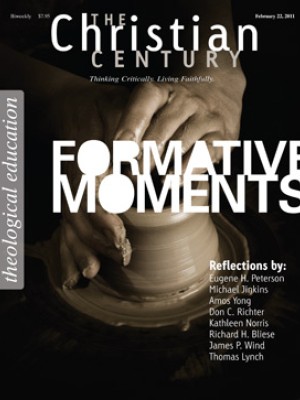Sunday, March 6, 2011: Matthew 17:1-9
I spent my early childhood on the high altiplano of Bolivia, where we took for granted spectacular views of mountains and lakes. I hiked the hills, explored caves and played among the Incan ruins. My siblings and I would accompany my parents by boat to villages and towns scattered around Lake Titicaca. Late-afternoon storms would come up quickly, churning the water, flashing sheet lightning and sometimes producing golf ball–size hail.
When I think about the transfiguration, I see those mountains again in all of their grandeur. I understand why earlier civilizations believed that mountains are close to the heavens; they have always symbolized a place where one may meet the holy.
Read our latest issue or browse back issues.
But in the 21st century, many of us don't live in the mountains or even outside of a city. What are we to think when we're invited into a story about a mountain shrouded in clouds? After all, this is no ordinary hike, and these are no ordinary clouds—they indicate the most Holy Presence.
If such an experience were to happen to us, how would we tell anyone about it? When a human moves from the flat, hot landscape of the ordinary into this extraordinary space, he or she finds fresh air and a vista pointing to vision and possibility. For Jesus' followers, there may have been the rush of wind, the swish and swirl of soft whiteness, a deep sense of shared experience.
There may also have been fear. For these men the moment caused them to take a step back as they reacted in wonder and even shock. It is the same for us: such an experience may frighten us to the core. We read the words in Matthew and hesitate, and in our unbelief we fail to experience the necessary fear, a God-induced fear of the possible, of the Savior present for our sake.
Why are we afraid and confused? In this seemingly silent text we experience what David Jaspers calls the "ambiguity and paradox of soundless sound." Matthew's story is a micronarrative without time and distance and space. This is the gospel extraordinariness of it all. We interpret the purpose of Jesus' life, death and resurrection in many ways, and too often our views take on a life of their own, pulling and grasping at us even as they validate a comfortable sameness and safety. We will do anything to try to mute and even contain the extraordinary message of this gospel narrative.
Ironically, in spite of their fear, the followers of Jesus wanted to pitch a tent and stay on the mountaintop. Perhaps their own rich narrative of faith, filled with their encounters with the holy, helped them hear the voice that claims a new way, a renewed hope and a powerful assurance of relationship. It's something that we 21st-century followers want too; we want to stay in the transfigured moment.
When such an experience happens to us, we are mesmerized as if by a scene captured in a snow globe or by fireworks lighting up the night sky. The flakes floating inside the magic globe finally settle on the ground; the fireworks are impossible to capture and keep. So it is with transformation and transfiguration. The elevated moments on the mountain are bound up in the ordinary and the sacred.
The search for the holy continues and will not go away despite predictions to the contrary. The yearning to find healing for the split between mind and heart permeates everyday conversation and stirs us to search high and low for answers. Often we are confounded and frustrated—sometimes feeling closer to the holy, then farther away again. Like mountain climbers, we make our way again and again up the side of the steep surface, even though we are warned that at the top of a mountain, clouds can suddenly wash over everything, blocking the view and confusing the climber, just as huge jets are grounded when clouds become too dense, too near.
One late autumn evening north of Tucson, Arizona, I sat outside and saw the strange glow of a full moon rising between mountain and clouds. The moon seemed to be moving, and as I timed its rising from behind the mountain (it took five minutes to emerge), I felt that if I stood at the right place at the right time, I might touch its silvery surface.
I know that the moon does not rise, and that it is the earth that is rotating. But for a moment that night I was convinced that it was not the earth but the moon that was moving.
We dare not discount the power of transformation. After all, there are Moses and Elijah, who teach us about the human struggle to grasp what our faith offers. And there are the companions of Jesus coming down the mountain, knowing that they were firmly grounded in a future that's yet to come.





